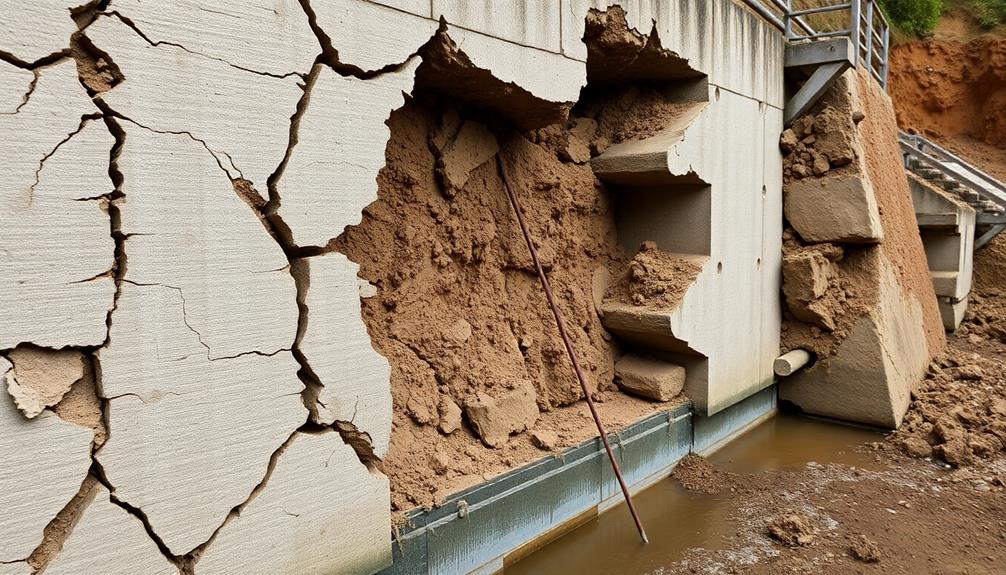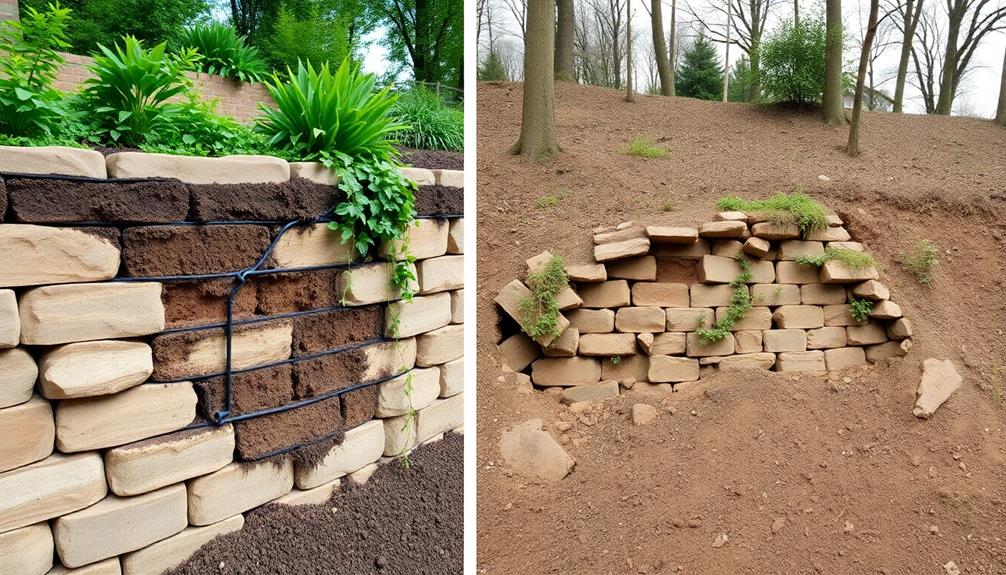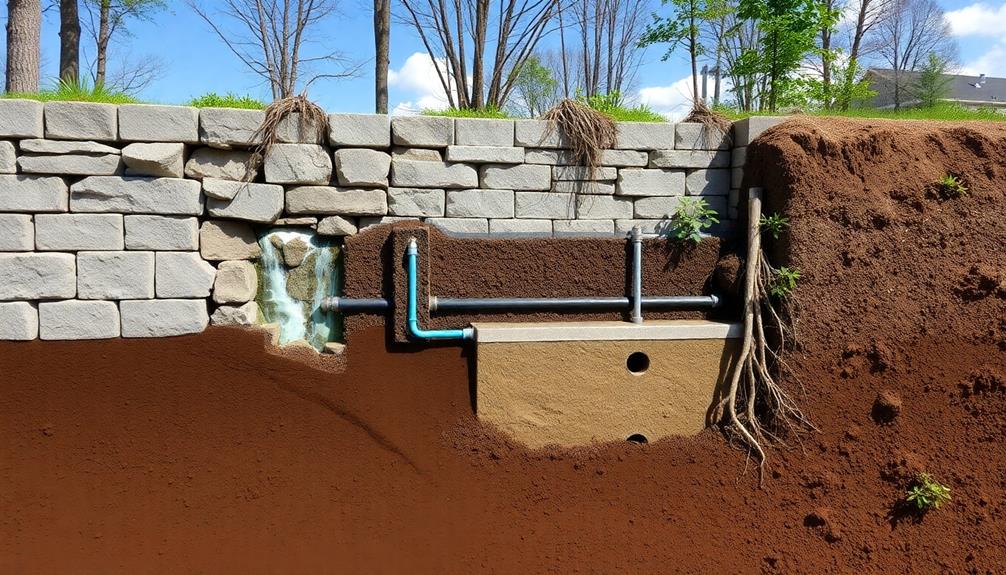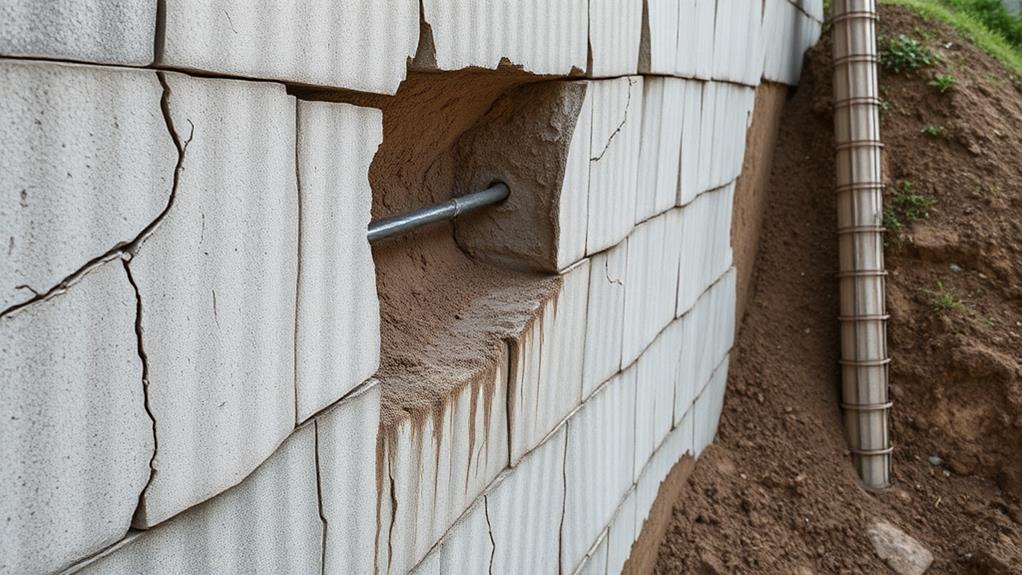Common mistakes in retaining wall design often stem from inadequate drainage systems, poor soil compaction, and incorrect material selection. These oversights can compromise structural integrity, leading to wall failure, costly repairs, and safety hazards. Insufficient water diversion methods, improper weep hole placement, and inadequate filter material selection are critical drainage system design flaws that can result in hydrostatic pressure buildup and soil instability. Additionally, neglecting proper soil compaction techniques impacts the wall's ability to withstand lateral pressures, causing settlement issues and deformation. Selecting inappropriate materials can lead to premature deterioration, soil erosion, and diminished property value. Understanding these common pitfalls is essential for creating durable, effective retaining walls.
Table of Contents
ToggleWalls Contractor Highlights
- Inadequate drainage system design, leading to hydrostatic pressure buildup and potential wall failure.
- Poor soil compaction, compromising the wall's ability to withstand lateral pressures and causing settlement issues.
- Incorrect material selection for wall construction, resulting in premature deterioration and structural integrity problems.
- Improper placement of weep holes, hindering effective water discharge and increasing internal pressure accumulation.
- Neglecting site-specific factors such as soil composition and groundwater levels when planning wall design and construction.
Structural Integrity Compromised by

The structural integrity of retaining walls can be severely compromised by several common design oversights. Inadequate drainage systems, poor soil compaction, and incorrect material selection are three critical factors that often lead to premature wall failure or decreased longevity.
Boulder retaining walls, while durable and long-lasting, require specialized installation expertise to guarantee proper construction and stability. Failing to account for site conditions and topography during the design phase can also contribute to structural issues.
These problems, when left unaddressed, can result in costly repairs, potential property damage, and safety hazards for nearby structures and individuals.
Inadequate Drainage Systems
Although often overlooked, inadequate drainage systems pose a significant threat to the structural integrity of retaining walls. Proper drainage is vital to prevent hydrostatic pressure buildup behind the wall, which can lead to structural failure over time.
Effective drainage systems typically include a combination of weep holes, perforated pipes, and well-designed backfill materials. These elements work together to channel water away from the wall, reducing the risk of soil erosion and maintaining the stability of the surrounding earth.
When designing retaining walls, engineers must consider the following critical aspects of drainage:
- Inadequate drainage can compromise the safety of nearby structures
- Poorly managed water flow may lead to costly repairs and potential liability issues
- Effective drainage systems protect your investment and guarantee long-term performance
- Neglecting proper drainage design can result in premature wall failure
- Well-designed drainage solutions contribute to the overall aesthetics of the landscape
Poor Soil Compaction
Many retaining wall failures can be attributed to poor soil compaction, a vital factor often underestimated during construction. Proper soil compaction is essential for ensuring the structural integrity and longevity of retaining walls, as it significantly impacts the wall's ability to withstand lateral earth pressures and prevent settlement issues. When soil layers behind the wall are not adequately compacted, they become susceptible to shifting and settling over time, potentially leading to wall deformation, instability, or complete collapse.
To achieve perfect soil compaction, contractors must adhere to strict guidelines and employ appropriate techniques. This includes using suitable compaction equipment, such as vibratory plate compactors or roller compactors, and compacting soil in thin lifts of 6 to 8 inches. Additionally, maintaining proper moisture content in the soil is crucial for achieving maximum density. Neglecting these practices can result in voids within the backfill, compromising the wall's load-bearing capacity and increasing the risk of failure.
Engineers and contractors must prioritize soil compaction as a fundamental aspect of retaining wall construction, ensuring that each layer is thoroughly compacted to meet specified density requirements and create a stable foundation for the structure.
Incorrect Material Selection
Selecting appropriate materials for retaining wall construction is crucial for ensuring structural integrity and longevity. Incorrect material selection can lead to premature deterioration, structural failure, and costly repairs. Engineers and contractors must consider factors such as soil type, climate conditions, and load-bearing requirements when choosing materials. Opting for substandard or incompatible materials may result in compromised structural integrity, potentially endangering property and lives.
To emphasize the importance of proper material selection, consider the following consequences of poor choices:
- Crumbling walls that threaten nearby structures
- Soil erosion and landscape instability
- Water seepage and foundation damage
- Costly repairs and potential legal liabilities
- Diminished property value and curb appeal
When selecting materials, professionals should prioritize durability, strength, and compatibility with the surrounding environment. High-quality concrete, properly treated timber, or engineered stone products are often suitable choices for retaining walls. Additionally, incorporating appropriate drainage materials and geotextile fabrics can enhance the wall's performance and longevity. By carefully considering material properties and environmental factors, designers can create retaining walls that not only meet structural requirements but also blend seamlessly with the landscape, providing both function and aesthetic appeal for years to come.
Benefits

While it's vital to avoid common mistakes in retaining wall design, it's equally important to recognize the significant benefits these structures can offer when properly executed. A well-designed retaining wall can substantially increase property value by enhancing landscape aesthetics and improving soil stabilization, thereby preventing erosion and potential land loss.
Boulder walls are particularly excellent for stairways and large walkways, providing customizable dimensions and long-lasting durability. Additionally, retaining walls facilitate efficient space utilization, allowing property owners to maximize usable land area in sloped or uneven terrain, creating functional outdoor living spaces or expanded gardening zones.
Increased Property Value
Beyond their functional purpose, well-designed retaining walls can greatly enhance a property's value. These structures not only prevent soil erosion and create usable space but also contribute substantially to the overall aesthetics and appeal of a landscape.
When executed properly, retaining walls can transform sloped or uneven terrain into attractive, multi-level gardens or outdoor living areas, effectively increasing the usable square footage of a property. This added functionality, combined with the visual appeal of a well-constructed retaining wall, can considerably boost a home's market value.
- Elevate your property's curb appeal with a stunning architectural feature
- Create additional outdoor living spaces for family gatherings and entertaining
- Showcase your commitment to property maintenance and improvement
- Differentiate your home in a competitive real estate market
- Invest in a long-lasting structure that adds value for years to come
Prospective buyers often view professionally designed retaining walls as a desirable feature, recognizing the added utility and aesthetic enhancement they provide. By addressing drainage issues, preventing soil erosion, and creating visually appealing outdoor spaces, these structures demonstrate a homeowner's dedication to property upkeep and improvement. This perception of added value can translate into tangible financial benefits when selling a property, potentially yielding a higher return on investment compared to other landscaping improvements.
Enhanced Landscape Aesthetics
Retaining walls offer more than just functional benefits and increased property value; they greatly enhance landscape aesthetics. These structures serve as architectural elements that can transform an ordinary outdoor space into a visually striking and cohesive environment. By incorporating different materials, textures, and designs, retaining walls can complement the existing landscape and architecture, creating a harmonious blend of natural and man-made elements.
When properly designed and executed, retaining walls can introduce various levels and dimensions to a landscape, adding depth and interest to otherwise flat or monotonous areas. They provide opportunities for creating distinct garden zones, terraced plantings, and elevated seating areas, all of which contribute to a more dynamic and engaging outdoor experience.
Additionally, retaining walls can be used to frame scenic views, direct foot traffic, and create focal points within the landscape. By integrating lighting elements, water features, or built-in planters, these structures can further elevate the aesthetic appeal of the property, turning functional necessities into artistic statements that enhance the overall beauty and character of the outdoor space.
Improved Soil Stabilization
One of the primary benefits of retaining walls is their ability to vastly improve soil stabilization. These structures effectively combat erosion, prevent landslides, and maintain the integrity of slopes in both residential and commercial settings. By redistributing lateral earth pressures and managing water drainage, retaining walls create a more stable environment for surrounding soil and vegetation. This enhanced stability not only protects property and infrastructure but also contributes to the overall safety of the landscape.
When properly designed and constructed, retaining walls offer numerous advantages for soil stabilization:
- Reduced risk of foundation damage to nearby structures
- Enhanced property value through improved land usability
- Prevention of soil movement during heavy rainfall or seismic activity
- Creation of level surfaces for gardening or outdoor living spaces
- Long-term reduction in maintenance costs associated with soil erosion
As members of a community invested in the longevity and safety of our surroundings, we recognize the importance of proper soil stabilization techniques. Retaining walls serve as an essential tool in our collective efforts to maintain the structural integrity of our landscapes, safeguarding our shared spaces and individual properties alike. By implementing these robust solutions, we contribute to a more resilient and sustainable environment for generations to come.
Efficient Space Utilization
Four key benefits of retaining walls in efficient space utilization stand out. First, these structures enable the creation of usable flat areas on sloped terrain, maximizing the potential of previously challenging landscapes. Second, retaining walls facilitate the development of multi-level outdoor spaces, allowing property owners to effectively double or triple their usable land area.
Third, they provide an opportunity for vertical gardening, transforming otherwise unused vertical surfaces into productive green spaces. In addition, retaining walls can be designed to incorporate built-in seating or storage elements, further optimizing space usage.
When properly implemented, retaining walls can greatly enhance the functionality and aesthetic appeal of a property. By strategically contouring the land, these structures create distinct zones for various activities, such as entertaining, gardening, or relaxation. Additionally, the integration of retaining walls into landscape design allows for improved drainage management, reducing soil erosion and water runoff issues. This not only protects the integrity of the property but also contributes to sustainable land use practices. As a result, property owners can enjoy a more efficient and versatile outdoor environment that caters to their specific needs and preferences.
Drainage System Design Flaws

Drainage system design flaws can severely compromise the integrity and longevity of retaining walls, leading to potential structural failures and costly repairs. These issues often stem from three primary sources: insufficient water diversion methods, inadequate filter material selection, and improper weep hole placement. Understanding these common mistakes is indispensable for engineers and contractors to design and construct retaining walls that effectively manage water pressure and prevent soil erosion.
| Design Flaw | Potential Consequences | Mitigation Strategies |
|---|---|---|
| Insufficient Water Diversion | Hydrostatic pressure buildup, wall instability | Implement proper grading, swales, and drainage pipes |
| Inadequate Filter Material | Soil erosion, clogged drainage systems | Use appropriate geotextiles and graded aggregates |
| Improper Weep Hole Placement | Ineffective water discharge, internal pressure accumulation | Strategic placement and sizing of weep holes |
Insufficient Water Diversion Methods
Neglect of proper water management can lead to catastrophic failures in retaining wall structures. Insufficient water diversion methods exacerbate hydrostatic pressure behind the wall, compromising its stability and longevity. Effective drainage systems, including weep holes, geotextile filters, and gravel backfill, are indispensable for channeling water away from the structure. Inadequate implementation of these elements can result in soil saturation, erosion, and eventual wall collapse.
To underscore the importance of proper water diversion, consider the following consequences:
- Soil instability and reduced load-bearing capacity
- Accelerated deterioration of wall materials
- Increased risk of frost heave in cold climates
- Foundation settlement and structural misalignment
- Potential for property damage and safety hazards
As professionals in the field, we must prioritize extensive drainage solutions in our retaining wall designs. By integrating robust water management techniques, we guarantee the longevity and reliability of these critical structures. Careful consideration of site-specific factors, such as soil composition, groundwater levels, and precipitation patterns, is vital for developing effective drainage strategies. Implementing a combination of surface and subsurface drainage methods, along with proper grading and landscaping, will dramatically mitigate the risks associated with water accumulation and protect the integrity of retaining walls for years to come.
Inadequate Filter Material Selection
While effective water diversion methods are paramount, the selection of appropriate filter materials plays an equally crucial vital role in retaining wall drainage system design. Many engineers and contractors overlook the importance of proper filter material selection, leading to potential long-term issues with wall stability and performance.
The primary function of filter materials is to prevent soil particles from migrating into the drainage system while allowing water to pass through freely. Inadequate filter material selection can result in clogged drains, reduced drainage efficiency, and increased hydrostatic pressure behind the wall. To avoid these issues, it's essential critical to choose filter materials that are compatible with the surrounding soil types and anticipated water flow rates. Geotextile fabrics and graded aggregate filters are commonly used, but their effectiveness depends on proper specification and installation.
When selecting filter materials, consider factors such as soil gradation, permeability requirements, and potential chemical interactions. Failure to account for these variables can lead to premature system failure and costly repairs. By investing time and resources in proper filter material selection, designers and builders can ensure the longevity and reliability of retaining wall structures, providing peace of mind for property owners and stakeholders.
Improper Weep Hole Placement
Despite their seemingly simple nature, weep holes play an essential role in the overall performance of retaining wall drainage systems. Improper placement of these vital drainage elements can lead to significant structural issues and compromise the wall's longevity.
Engineers must carefully consider factors such as spacing, size, and location when designing weep hole configurations. Failure to do so may result in inadequate water removal, increased hydrostatic pressure, and potential wall failure.
To underscore the importance of proper weep hole placement, consider the following emotional impacts of drainage system failures:
- Devastating property damage due to wall collapse
- Costly repairs and potential legal liabilities
- Loss of client trust and professional reputation
- Environmental degradation from soil erosion
- Safety hazards for nearby residents and pedestrians
Effective weep hole placement requires an extensive understanding of site-specific conditions, including soil composition, groundwater levels, and anticipated water flow patterns. Engineers should employ advanced modeling techniques to optimize drainage system design, ensuring that weep holes are strategically positioned to efficiently channel water away from the retaining wall structure.
Walls Contractor FAQ
How Often Should Retaining Walls Be Inspected for Potential Issues?
Retaining walls should be inspected annually, or more frequently in areas prone to extreme weather or seismic activity. Regular inspections help identify potential issues early, ensuring the safety and longevity of the structure for our communities.
What Are the Best Materials for Building Long-Lasting Retaining Walls?
For long-lasting retaining walls, consider durable materials like reinforced concrete, natural stone, or engineered blocks. These options offer strength, stability, and aesthetic appeal. Proper drainage and professional installation are essential for ensuring longevity and performance in our community's structures.
Can Existing Retaining Walls Be Reinforced Without Complete Reconstruction?
Yes, existing retaining walls can often be reinforced without complete reconstruction. Options include adding anchors, soil nails, or buttresses, depending on the wall's condition and site constraints. Professional assessment is recommended to determine the most suitable reinforcement method.
How Do Soil Types Affect Retaining Wall Design and Construction?
Soil types greatly influence retaining wall design and construction. Cohesive soils require different drainage solutions than granular soils. Clay soils may necessitate deeper foundations. Comprehending soil properties guarantees we create stable, long-lasting structures for our communities.
What Permits Are Typically Required for Building Residential Retaining Walls?
For residential retaining walls, permits often include building permits, grading permits, and potentially zoning permits. Requirements vary by location, so it's critical to consult your local building department to guarantee compliance with community regulations and safety standards.







